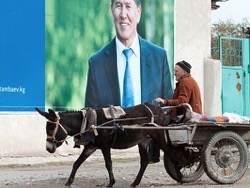
Central Asia, despite its geographical proximity to Russia, is something distant and incomprehensible to the average Russian citizen. The whole set of knowledge about the region is usually limited by the pilaf recipe and migrant workers. And all anything, if not for the baggage of the problems of these countries, which can touch and Russia. Furthermore, the region in the near future will be able safely to become a new hot spot and to claim the role of a new Middle East.
By itself, Central Asia – is rather problematic region. Crisis phenomena are observed almost everywhere: from Economics and social sphere and to ideological and political problems. On this basis, it is likely that even without external intervention here may have a serious shock, which may ultimately lead to irreversible processes in a scenario of “color revolutions” or “Arab spring”.
The misery and destruction
You should start, perhaps, with the economy. The poorest country in the region is Tajikistan. There is de-industrialization, in which the role of agriculture with decreasing share of industrial production in the economy. The process is accompanied by the destruction of infrastructure and industries. Helps to survive a significant economic dependence on Russia: the major share of Tajikistan’s GDP depends on remittances from labour migrants from our country. If in 2014 the GDP in current prices amounted to 9.2 billion dollars, in the 2015 index fell to 3.28 billion.
According to the IMF, and without that weak economy of the region suffered greatly from the decline in energy prices and the crisis of the Russian economy. The organization predicted the growth of inflation in Kyrgyzstan up to 10.7%, and real GDP growth of 1.7%. According to experts, it is the worst rate over the past 15 years. This trend is growing in other countries of the region. Although the official statistics of Tajikistan estimates inflation at 3.6%, the IMF analysts claim to 12.8%. However, judging by the fact that the authorities try to control all spheres, according to official figures meaningless. The same situation in Uzbekistan: IMF forecast GDP slowing to 6.5% and inflation at 9.8% in 2016. The most stable country in economic terms, analysts have recognized Turkmenistan, but here is not rosy, as the country depends on energy exports. In the end, as experts conclude, the only way for countries in the region is financial reform.
One of the key problems of the region is poverty.
Global Finance publishes the ranking of countries in terms of wealth/poverty. The first in the rating are the richest country in the world. From the Central Asian region, only 2 countries have entered the first hundred of the rating is Kazakhstan (50th place) and Turkmenistan (77). However, these are rather exceptions. Countries such as Uzbekistan, Kyrgyzstan and Tajikistan in poverty are in a single list with African countries. Presented in the ranking they occupy 127, 142 and 153, respectively. The ratings for quality of life nor is no country from Central Asia, except Kazakhstan.
Political regimes in the Asian traditions
Economic tension is complemented by the reluctance of most countries in the region to reform its model of political structure. Political analysts there are 3 models of the development of forms of government in the region. As usual, a special case is Kazakhstan, where the so-called authoritarian modernization. The process started since the 90s, when was adopted last Constitution, which was soon got authoritarian interpretation. In the end, this resulted in the design of the special status of the President. However, since 2014, President Nazarbayev declared policy of decentralization. Early elections opened the way of the power elite of new politicians. However, we should not build illusions on this score: in the country remains tough authoritarian power.
The second path went to Kyrgyzstan, in which the constitutional revolution is considered as an alternative to authoritarianism. The country experimented with its constitutional system. Now researchers are inclined to believe that Kyrgyzstan is in transition after the presidency of Bakiyev. Likely presidential power will increase.
The third and most unpromising model was established in Turkmenistan, Tajikistan and Uzbekistan.
The main trend here is the rejection of political reform for preservation of traditional modes. The form of government of Turkmenistan belong to the exotic dictatorships, in characteristics close to sultanism.
History the current Tajik and Uzbek regimes unites the aspect of the struggle against the Islamic opposition. While in Tajikistan it led to authoritarianism and the establishment of a personal authority of President Rahmonand Uzbekistan the authorities try to abandon liberal reforms.
All political regimes of the countries of Central Asia share a number of similarities.
First, they are all weak and can be destroyed at any moment, at least, due to socio-economic problems.
Secondly, for most countries is the problem of inheritance of personal power. In the history of the region there was not a single lawful transfer of power. More or less I think you made the transfer of power in Turkmenistan, where local clans have come to an agreement, making President Gurbanguly Berdimuhamedov. Gradually and in Kyrgyzstan starting to get used to the election.
In Uzbekistan the situation is a stalemate: the current President Karimov, 78 years old, he has no heir, and within the political elite discord. How will the change of power in the country is anyone’s guess.
In Tajikistan also, it is totally unclear what the outcome of the concentration of power and persecution of the opposition. Rahmon came to the fact that the authorities are only relatives and close friends of the President, and former high-ranking officials lose their jobs. Only in this country could be a situation when senior officials go to the IG in the search for justice.
Activation of terrorists
All the problems outlined above in Central Asia made it a suitable target for the expanding circle of terrorist organizations. People living in such conditions, become easy prey for recruiters. Information about activation of the IG (DAYS) on the territory of the region appeared in 2014. It DOES joined a large terrorist group “Islamic movement of Uzbekistan” (IMU), which for years haunts the Uzbek authorities. This was followed by an improvement in the work of a secret network of terrorists, who have intensified the recruitment and training of militants. A few months before this on one of the bridges of Tashkent by unknown was hung a flag DAYS.
According to various sources, under black-and-white rags of extremists fighting from 2 to 4 thousands of natives of Central Asia. Of course, there is no accurate data: official statistics, as usual, underestimates the data. Vice Prime Minister of Kyrgyzstan Abdyrakhman Mamataliev in 2015 talked about 330 citizens in DAYS. The Ministry of the interior cites similar figures – 386.
This is not surprising, since the conditions in these countries are close to those under which was formed this terrorist organization. One of the reasons for the emergence of the “Islamic state” political analysts say discontent of national elites who were trying to create a stable secular regimes.
The reaction of the radical part of the population was the formation of terrorist groups. First there was the ISIL (Islamic state of Iraq and the Levant), the claims of which spread to a limited number of territories. Then the project has expanded to project a worldwide Islamic Caliphate.
Of course, play a role and economic conditions. As noted by a member of the Expert-analytical Council at the Committee for CIS Affairs and compatriots of the state Duma Boris Podoprigora, in the territory of Central Asia no geographic barriers that would sejati fighters.

“But the Muslim population. The population is, to put it mildly, not rich. So you can count on the fact that it’s propaganda ISIS would react, at least, not antagonistic.”
Boris Podoprigora
This should not be limited to economic-social and political reasons. There is a great importance of the ideological factor. Of course, Central Asian leaders were able to overcome the Islamic opposition, but they are unable to offer anything in return. In sane countries don’t have national ideas that could unite the population. In this case the lack of religious literacy. Recruiters differently are some excerpts from the Quran, interpreting the text differently depending on the purpose. Natives of Central Asia can’t argue with these provisions because of a banal lack of knowledge. According to experts, spiritual books, common in the region, just unreadable. How in such conditions to take religious education?
However, very few people care about this issue. Think about it, only Russia in connection with a direct threat that appears in connection with the activation of DAYS in the region. Trained Central Asian fighters return home, where they share knowledge with their compatriots. As labor migrants, they return to Russia. As stated by the head of the Kremlin administrationSergey Ivanov in September:

“Some of them have already returned to the territory of the Russian Federation. And it is easy to assume that they will continue to come back to our territory”.
Ivanov Sergey Borisovich
A true personification of the threat from terrorist propaganda in Central Asia is the recent murder of a child by a babysitter from Uzbekistan. Despite the fact that she was found incompetent to stand trial, the investigation became known that her husband is under the influence of extremist propaganda.
At the October summit of CIS heads of state Vladimir Putin said about the readiness of the extremists in the region. According to him, the number of immigrants from countries participating in the summit, who are fighting in the ranks of DAYS reaches 5-7 thousand.

“The terrorists of various stripes are gaining more and more influence and do not hide plans for further expansion. One of their goals is to break into the Central Asian region. It is important for us to be prepared to consistently respond to such a scenario”.
Putin Vladimir Vladimirovich
This summit has shown an important trend: despite some distancing of countries from the policy of Moscow, the security threat is forcing them to reconsider their views. The only problem is that the leaders do not think about the main thing – about the transformation of modes. This step can solve a range of problems, which includes security.
The interests of Russia and China in Central Asia
As the researchers note in this region, amid a recession in Russia, China intensified its foreign policy in Central Asia. Without a doubt, China is a key geopolitical player, who invests a huge investment in the economy of countries. Data on investment are fragmentary, but some well-known facts allow us to estimate their scale.
So, in Kazakhstan, on the Chinese company accounts for about a quarter of oil production of the country. Their share is even higher than the share of the national company “KazMunaiGas”. In addition, China’s trade turnover with Kazakhstan, Kyrgyzstan, Tajikistan, Turkmenistan and Uzbekistan in the aggregate increased from $ 1.8 billion to 50 billion over 13 years (2000-2013).
According to experts, at this stage, the size of Chinese investments in these countries at 10.7 times higher than the Russian. These data allow some analysts to conclude that China is displacing Russia from the region.
In addition, there is the appeal of the project of the silk road, aimed at the development of infrastructure in the region. This project is often counter with the Russian integration project the Eurasian economic Union. Based on this, many analysts are inclined to dramatize the situation. Actually no one takes into account the difference between the models of the foreign policy of China and Russia. And this factor explains a lot.
To start, perhaps, is with the fact that China does not care about the Central Asian regimes. Of course, the problems between Afghanistan and Turkmenistan, which is the main exporter of gas in the PRC may have an impact on Chinese security.
But the Foundation of China’s foreign relations in General and Central Asia in particular is the economy. Do not look at the actions of the leadership with some extra overtones, directed against Russia.
For example, the project silk road is not opposed to integration within the Eurasian economic Union, but rather an addition. Especially it became obvious after the agreement Putin and XI Jinping about the pairing of these projects.
Russia has a different model of behavior. Russia, indeed, concerned about the political situation in these countries, at least, for reasons of their own safety, as a maximum, due to historical ties. And in fairness, Chinese investment is not the only component of the economy of countries.
According to the data of 2014, the main importer of Kazakhstan remains Russia, whose share is 32.2%, while China is in second place with a share of 29%. In the top five trade partners of Kyrgyzstan on export of China is not, but there is Russia, which accounts for 5.9 per cent. In imports the situation is the opposite, the share of Chinese goods in the importing country exceeds 54%. Although the export of Turkmenistan on 70% belongs to China, its share in the Russian imports is less than 3.7%.
All these factors demonstrate rather not fight and cooperation between China and Russia in the region.
In addition, the GDP of some countries of Central Asia hinges on cross-border transfers from Russia. In the first quarter of 2015 the Central Bank had also experienced a slump that led to economic in Uzbekistan, Tajikistan and Kyrgyzstan. This does not play into the hands of the current authorities, who often receive awkward questions than can use Islamic radicals have.
Bomb threat
Despite the efforts of Russia and China in support of stability in Central Asia, however, the threat of the coming to power of extremists in the region is growing every year and makes me the most anxious expectations.
First of all, under attack by extremists of DAYS will most likely enter Tajikistan and Uzbekistan as the most problematic country. This can lead to huge refugee flows, civil wars on the southern borders, the increasing number of terrorists in the Caucasus, and the collapse of the Eurasian integration project.
Does Russia need a new hot spot on the borders, in the southern underbelly? Obviously not. That is why Russia is so interested in the development of countries of Central Asia and their reintegration in the framework of the Eurasian project. In the field of security need to more actively engage the collective security Treaty organization, membership in which are Kazakhstan, Kyrgyzstan and Tajikistan – as long as the structure is quite passive. Just need more dense humanitarian and information cooperation: the inhabitants of the former republics of the USSR should be noted that Russia has returned to the region, without compromising sovereignty.
It must be understood that if the States of Central Asia will continue to degrade, sort of the legacy of past years, they soon will come the terrorists with black flags. And problems have to be solved through different ways.








